Pattern 1939 Leather Infantry Equipment
Equipment Carriers - Frogs, Pouches, & Pockets
Pattern 1914 Leather Infantry Equipment employed brass fittings that dated back to Victorian times. Pattern 1939 Leather Infantry Equipment - let’s ascribe a derived nomenclature – utilised the standard M.E.Co. brass buckles. In place of stitching, thereby simplifying the manufacturing process, Hose Rivets were used throughout the Pattern. Stitching was only used to secure the fibre linings to the edges of the leather parts.
![]()
![]() This is an official nomenclature, taken from the 1942 Home Guard equipment scale. These were leather replicas of the 1st Issue Patt. ’37 W.E. Frogs. Rivetted throughout, they have been noted in pebbled brown and smooth black leather. The Home Guard were equipped with the U.S. .300-in. M-1917 Rifle, which in .303 was Rifle, No. 3, or the P.’14. To distinguish the different calibres, H.G. weapons had a red band painted around the fore-end. With the U.S. rifle came its U.S. M-1917 Bayonet, which were supplied in scabbards akin to the U.K. version, but the locket had an integrated, hinged hanger hook incorporated into the closing plate over the mouth of the scabbard. These scabbards therefore had no frog stud, so were slipped into the Patt. ’39 Frog and prevented from slipping through the Frog by the plate with its hanger hook. It was a close, but not tight fit, so regulation bayonet drill, at the “Fix bayonets” command, must have been interesting. From the Chris Pollendine Collection. Photographs © Chris Pollendine, 2010.
This is an official nomenclature, taken from the 1942 Home Guard equipment scale. These were leather replicas of the 1st Issue Patt. ’37 W.E. Frogs. Rivetted throughout, they have been noted in pebbled brown and smooth black leather. The Home Guard were equipped with the U.S. .300-in. M-1917 Rifle, which in .303 was Rifle, No. 3, or the P.’14. To distinguish the different calibres, H.G. weapons had a red band painted around the fore-end. With the U.S. rifle came its U.S. M-1917 Bayonet, which were supplied in scabbards akin to the U.K. version, but the locket had an integrated, hinged hanger hook incorporated into the closing plate over the mouth of the scabbard. These scabbards therefore had no frog stud, so were slipped into the Patt. ’39 Frog and prevented from slipping through the Frog by the plate with its hanger hook. It was a close, but not tight fit, so regulation bayonet drill, at the “Fix bayonets” command, must have been interesting. From the Chris Pollendine Collection. Photographs © Chris Pollendine, 2010.
Note the stitching on the body of the Frog, which would seem un-necessary, as more rivets could have secured the doubled portion.
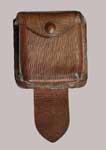
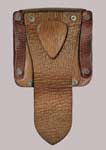
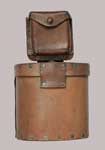
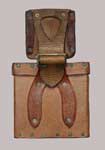 Construction is detailed for the Pistol Ammunition Pouch below. Lined with felt, it was designed more for the strangely un-punctuated Compass magnetic marching Mark I which, to un-tutored eyes, was a very ersatz looking offering in a squared black Bakelite case. Not quite the Prismatic Compass, but it evidently did the job! On its rear face, an extension tab was riveted and long enough to be secured to the 2-inch buckle on the Binocular case. Belt loops were riveted each side. The extension tab had a large hole. This was set sufficiently high to leave a transverse “loop”, corresponding to that of Patt. ’37 version.
Construction is detailed for the Pistol Ammunition Pouch below. Lined with felt, it was designed more for the strangely un-punctuated Compass magnetic marching Mark I which, to un-tutored eyes, was a very ersatz looking offering in a squared black Bakelite case. Not quite the Prismatic Compass, but it evidently did the job! On its rear face, an extension tab was riveted and long enough to be secured to the 2-inch buckle on the Binocular case. Belt loops were riveted each side. The extension tab had a large hole. This was set sufficiently high to leave a transverse “loop”, corresponding to that of Patt. ’37 version.
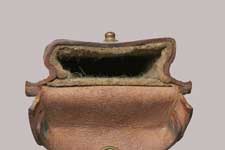 A top view, open, to illustrate the felt lining. The Pocket and Binocular case shown here are both from the John Bodsworth Collection. Photographs © John Bodsworth 2010.
A top view, open, to illustrate the felt lining. The Pocket and Binocular case shown here are both from the John Bodsworth Collection. Photographs © John Bodsworth 2010.
Pocket, compass, 1st Issue (tab removed)
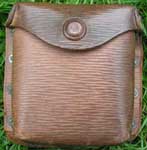
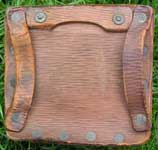 The extension tab was cut off, as here, or removed completely. When assembled to the Binocular case, the base of the Pocket interfered with opening the Binocular case. Photos courtesy of War Department Militaria, © Paul Laidlaw 2010.
The extension tab was cut off, as here, or removed completely. When assembled to the Binocular case, the base of the Pocket interfered with opening the Binocular case. Photos courtesy of War Department Militaria, © Paul Laidlaw 2010.
Pouch, ammunition, pistol, 1st Issue
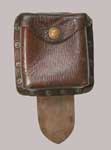
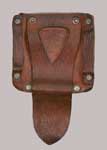

 This was constructed in two pieces, the front blocked to shape and riveted with four hose rivets on each side and the lower edge. Note the missing corners, where the edges are splayed out to lie flat on the backing piece. Whilst this evoked the “flanged” form of Patt. ’37, it was simply an expedient way of forming a pocket. The flap was cut at each edge, gathered and riveted to form a hooded flap. Closure was with a press fastener. On the rear face, a 2-inch wide pointed tab was stitched, which connected to the 2-inch buckle on the Pistol case, again with a hole, as detailed above.
This was constructed in two pieces, the front blocked to shape and riveted with four hose rivets on each side and the lower edge. Note the missing corners, where the edges are splayed out to lie flat on the backing piece. Whilst this evoked the “flanged” form of Patt. ’37, it was simply an expedient way of forming a pocket. The flap was cut at each edge, gathered and riveted to form a hooded flap. Closure was with a press fastener. On the rear face, a 2-inch wide pointed tab was stitched, which connected to the 2-inch buckle on the Pistol case, again with a hole, as detailed above.
As with the 2-inch buckle, on Patt. ’08 Cartridge carriers, the “gated” side faced downwards and therefore inwards. The Pouch attached to the Pistol case, as shown here. The hole in the tab strap gave clearance for the Brace attachment, which was passed – belt loop first – downwards behind the upper side of the hole. From the John Bodsworth Collection. Photographs © John Bodsworth 2010.


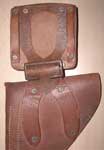
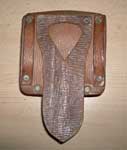 The accompanying photos are of a simulacrum, created with the leatherworking skills of Chris Pollendine. It is intended only to demonstrate the principles, as memories are two against one – that the hole was smaller! Photos of the actual items have now been added, but we've kept these in, and added a new picture of Chris's new, modified pouch (far right). From the Chris Pollendine Collection. Photographs © Chris Pollendine 2010.
The accompanying photos are of a simulacrum, created with the leatherworking skills of Chris Pollendine. It is intended only to demonstrate the principles, as memories are two against one – that the hole was smaller! Photos of the actual items have now been added, but we've kept these in, and added a new picture of Chris's new, modified pouch (far right). From the Chris Pollendine Collection. Photographs © Chris Pollendine 2010.
Pouch, ammunition, pistol, 2nd Issue
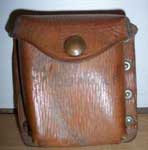
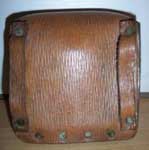 The colloquial, collector’s term for this simplified version is “Patt. ‘40”, being the matching Pouch for the simplified Holster, having only two narrow belt loops on the rear face. The reasons for its existence are unknown, but see its corresponding Pistol case for some speculation. From the R.J. Dennis Collection. © R.J. Dennis, 2010
The colloquial, collector’s term for this simplified version is “Patt. ‘40”, being the matching Pouch for the simplified Holster, having only two narrow belt loops on the rear face. The reasons for its existence are unknown, but see its corresponding Pistol case for some speculation. From the R.J. Dennis Collection. © R.J. Dennis, 2010
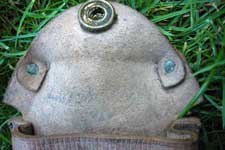 The view at near left illustrates how this and the Compass pocket were given “hooded” flaps, for improved weatherproofing. Photo courtesy of War Department Militaria, © Paul Laidlaw 2010.
The view at near left illustrates how this and the Compass pocket were given “hooded” flaps, for improved weatherproofing. Photo courtesy of War Department Militaria, © Paul Laidlaw 2010.
Rog Dennis, December, 2010